Moderate overlap front: original test
Rating applies to 2004-06 models
Tested vehicle: 2004 Hyundai Elantra GLS 4-door
The Hyundai Elantra was redesigned for the 2001 model year. The Institute evaluated the 2001 Elantra and identified a problem with the airbag system. The driver frontal airbag fired late in two crashes resulting in high head injury measures.
All 2004 and later Elantra models have redesigned driver frontal airbags and all 2004 and later Elantras manufactured after August 2003 also include redesigned passenger frontal airbags. (Information about when a specific vehicle was manufactured is on the certification label typically affixed to the car on the driver door or adjacent B-pillar.) At the request of Hyundai, the Institute agreed to test the 2004 Elantra with the redesigned airbag system.
The Insurance Institute for Highway Safety has evaluated the crashworthiness of the 2004 Elantra with the redesigned driver and passenger airbags in three 40 mph moderate overlap frontal crash tests into deformable barriers. A fuel leak occurred in the first test. Hyundai identified a fuel hose clamp that was improperly positioned, which led to puncturing of the fuel tank during the crash. Hyundai has recalled the affected models to reposition the hose clamp. A second test was conducted to assess the effect of the fix.
In the second test, no fuel leakage occurred, but the driver frontal airbag failed to deploy. This led Hyundai to modify the frontal airbag deployment characteristics beginning with 2005 models produced after December, 2004. Also, Hyundai initiated a recall to modify at its cost 2004-05 models produced earlier. The Institute tested a third Elantra with the modified airbags, and the driver airbag inflated properly.
The evaluation of the Elantra below is based on the first and third tests, except for the structural rating, which is based on all three tests.
| Overall evaluation | |
|---|---|
| Structure and safety cage | |
| Driver injury measures | |
| Head/neck | |
| Chest | |
| Leg/foot, left | |
| Leg/foot, right | |
| Driver restraints and dummy kinematics |
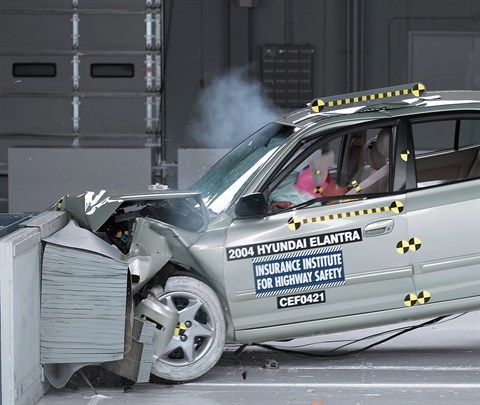
Action shot taken during the third of three frontal crash tests.
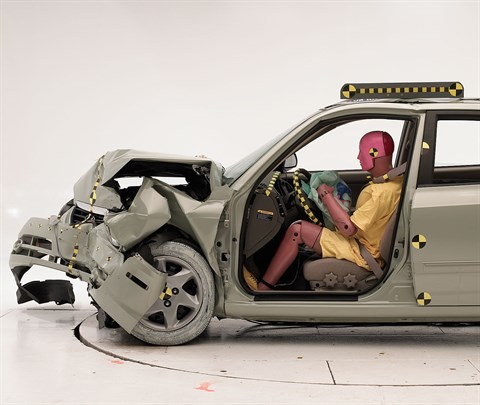
The dummy's position in relation to the steering wheel and instrument panel after all three crash tests indicates that the driver's survival space was maintained well (third test shown).

A high head acceleration occurred when the dummy's head hit the steering wheel in the first and third tests (third test shown).
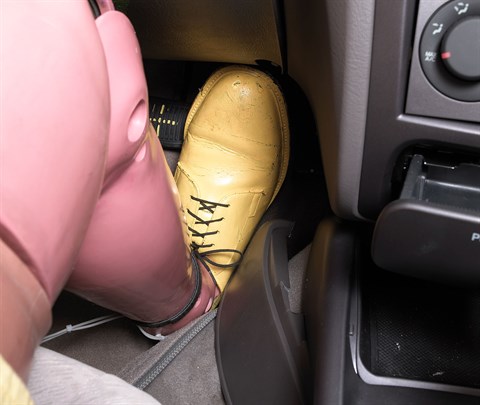
Forces on the lower right leg were high enough to indicate the possibility of injury in the third test.
Measures of occupant compartment intrusion on driver side
| Test ID | CEF0410 | CEF0416 | CEF0421 |
|---|---|---|---|
| Footwell intrusion | |||
| Footrest (cm) | 12 | 10 | 12 |
| Left (cm) | 16 | 14 | 18 |
| Center (cm) | 12 | 12 | 15 |
| Right (cm) | 9 | 11 | 13 |
| Brake pedal (cm) | 6 | 7 | 8 |
| Instrument panel rearward movement | |||
| Left (cm) | 4 | 5 | 6 |
| Right (cm) | 3 | 5 | 6 |
| Steering column movement | |||
| Upward (cm) | -3 | -3 | -1 |
| Rearward (cm) | 0 | 4 | 4 |
| A-pillar rearward movement (cm) | 2 | 3 | 4 |
Driver injury measures
| Test ID | CEF0410 | CEF0421 | |
|---|---|---|---|
| Head | |||
| HIC-15 | 288 | 302 | |
| Peak gs at hard contact | 117 | 74 | |
| Neck | |||
| Tension (kN) | 1.2 | 1.4 | |
| Extension bending moment (Nm) | 26 | 18 | |
| Maximum Nij | 0.26 | 0.26 | |
| Chest maximum compression (mm) | 28 | 23 | |
| Legs | |||
| Femur force - left (kN) | 1.1 | 2.6 | |
| Femur force - right (kN) | 5.5 | 6.7 | |
| Knee displacement - left (mm) | 0 | 0 | |
| Knee displacement - right (mm) | 6 | 12 | |
| Maximum tibia index - left | 0.55 | 0.71 | |
| Maximum tibia index - right | 0.68 | 1.00 | |
| Tibia axial force - left (kN) | 1.7 | 1.7 | |
| Tibia axial force - right (kN) | 2.9 | 6.2 | |
| Foot acceleration (g) | |||
| Left | 72 | 52 | |
| Right | 92 | 99 | |
Side: original test
Rating applies to 2001-06 models
Tested vehicle: 2005 Hyundai Elantra GLS 4-door with standard front seat-mounted combination head and torso airbags
The Hyundai Elantra was redesigned for the 2001 model year.
| Overall evaluation | |
|---|---|
| Structure and safety cage | |
| Driver injury measures | |
| Head/neck | |
| Torso | |
| Pelvis/leg | |
| Driver head protection | |
| Rear passenger injury measures | |
| Head/neck | |
| Torso | |
| Pelvis/leg | |
| Rear passenger head protection The dummy's head was hit by the window frame, glass, and sill of the rear passenger door, producing moderately high head injury measures. |
|
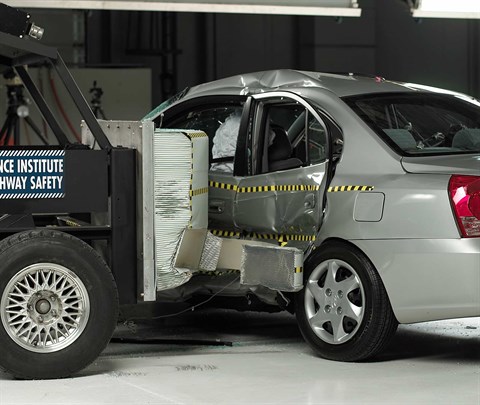
View of the vehicle and barrier just after the crash test.
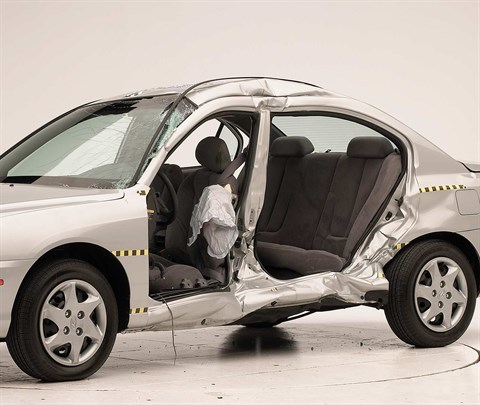
View of the vehicle after the crash with doors removed, showing the side airbag and damage to the occupant compartment.

Action shot taken during the side impact crash test showing the driver dummy's head was protected from being hit by hard structures by the side airbag.
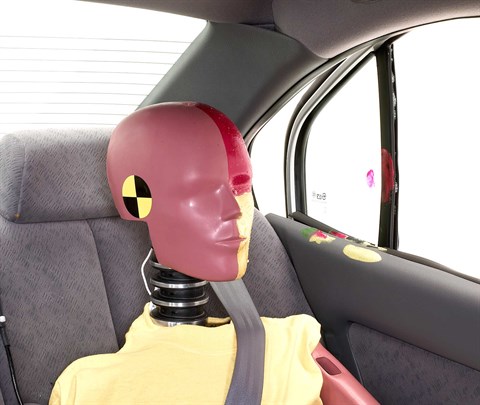
Smeared greasepaint shows where the rear passenger dummy's head was hit by the window frame, glass, and sill of the rear passenger door.
Measures of occupant compartment intrusion on driver side
| Test ID | CES0503 |
|---|---|
| B-pillar to longitudinal centerline of driver's seat (cm) | -2.0 |
| Negative numbers indicate the amount by which the crush stopped short of the seat centerline. | |
Driver injury measures
| Test ID | CES0503 |
|---|---|
| Head HIC-15 | 301 |
| Neck | |
| Tension (kN) | 1.0 |
| Compression (kN) | 0.2 |
| Shoulder | |
| Lateral deflection (mm) | 44 |
| Lateral force (kN) | 1.5 |
| Torso | |
| Maximum deflection (mm) | 55 |
| Average deflection (mm) | 44 |
| Maximum deflection rate (m/s) | 7.22 |
| Maximum viscous criterion (m/s) | 1.70 |
| Pelvis | |
| Iliac force (kN) | 2.7 |
| Acetabulum force (kN) | 2.4 |
| Combined force (kN) | 5.0 |
| Left femur | |
| L-M force (kN) | 0.4 |
| L-M moment (Nm) | 255 |
| A-P moment (Nm) | 38 |
Passenger injury measures
| Test ID | CES0503 |
|---|---|
| Head HIC-15 | 662 |
| Neck | |
| Tension (kN) | 2.1 |
| Compression (kN) | 0.6 |
| Shoulder | |
| Lateral deflection (mm) | 43 |
| Lateral force (kN) | 1.9 |
| Torso | |
| Maximum deflection (mm) | 45 |
| Average deflection (mm) | 42 |
| Maximum deflection rate (m/s) | 4.02 |
| Maximum viscous criterion (m/s) | 0.91 |
| Pelvis | |
| Iliac force (kN) | 1.1 |
| Acetabulum force (kN) | 2.9 |
| Combined force (kN) | 3.6 |
| Left femur | |
| L-M force (kN) | 1.2 |
| L-M moment (Nm) | 169 |
| A-P moment (Nm) | -57 |
Head restraints & seats
Seat type: All seats
| Overall evaluation | |
|---|---|
| Dynamic rating | |
| Seat/head restraint geometry |
| Seat type | All seats |
|---|---|
| Geometry | |
| Backset (mm) | 82 |
| Distance below top of head (mm) | 62 |
| Seat design parameters | |
| Pass/fail | Fail |
| Max T1 acceleration (g) | 14.3 |
| Head contact time (ms) | 110 |
| Force rating | 3 |
| Neck forces | |
| Max neck shear force (N) | 427 |
| Max neck tension (N) | 1,490 |
How the head restraint & seat test is conducted
Currently, IIHS tests apply only to front seats.
